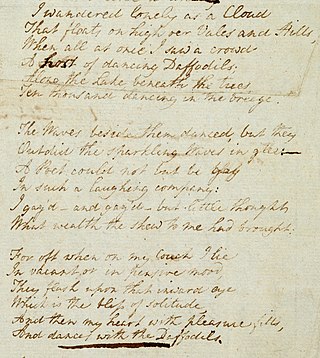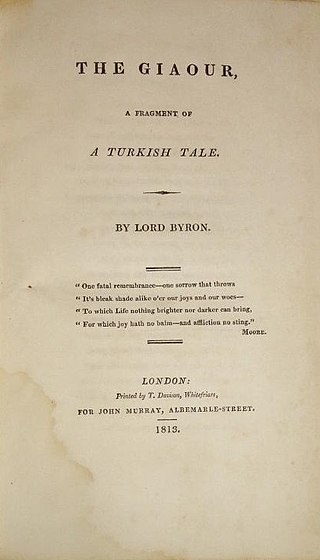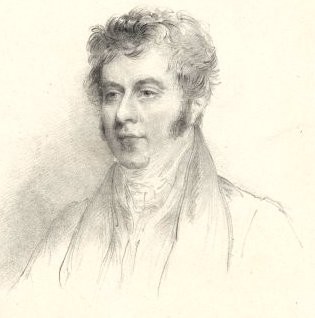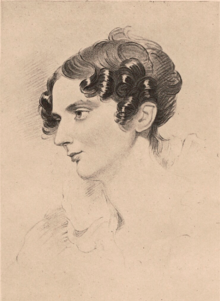
John Keats was an English poet of the second generation of Romantic poets, along with Lord Byron and Percy Bysshe Shelley. His poems had been in publication for less than four years when he died of tuberculosis at the age of 25. They were indifferently received in his lifetime, but his fame grew rapidly after his death. By the end of the century, he was placed in the canon of English literature, strongly influencing many writers of the Pre-Raphaelite Brotherhood; the Encyclopædia Britannica of 1888 called one ode "one of the final masterpieces".

John Wilmot, 2nd Earl of Rochester was an English poet and courtier of King Charles II's Restoration court, who reacted against the "spiritual authoritarianism" of the Puritan era. Rochester embodied this new era, and he became as well known for his rakish lifestyle as for his poetry, although the two were often interlinked. He died as a result of a sexually transmitted infection at the age of 33.
Ottava rima is a rhyming stanza form of Italian origin. Originally used for long poems on heroic themes, it later came to be popular in the writing of mock-heroic works. Its earliest known use is in the writings of Giovanni Boccaccio.

"I Wandered Lonely as a Cloud" is a lyric poem by William Wordsworth. It is one of his most popular, and was inspired by a forest encounter on 15 April 1802 that included himself, his younger sister Dorothy and a "long belt" of daffodils. Written in 1804, this 24 line lyric was first published in 1807 in Poems, in Two Volumes, and revised in 1815.

Clara Mary Jane Clairmont, or Claire Clairmont as she was commonly known, was the stepsister of the writer Mary Shelley and the mother of Lord Byron's daughter Allegra. She is thought to be the subject of a poem by Percy Bysshe Shelley.

Childe Harold's Pilgrimage is a long narrative poem in four parts written by Lord Byron. The poem was published between 1812 and 1818. Dedicated to "Ianthe", it describes the travels and reflections of a young man disillusioned with a life of pleasure and revelry and looking for distraction in foreign lands. In a wider sense, it is an expression of the melancholy and disillusionment felt by a generation weary of the wars of the post-Revolutionary and Napoleonic eras. The title comes from the term childe, a medieval title for a young man who was a candidate for knighthood.

The Giaour is a poem by Lord Byron first published in 1813 by John Murray and printed by Thomas Davison. It was the first in the series of Byron's Oriental romances. The Giaour proved to be a great success when published, consolidating Byron's reputation critically and commercially.

In English literature, Don Juan, written from 1819 to 1824 by the English poet Lord Byron, is a satirical, epic poem that portrays the Spanish folk legend of Don Juan, not as a womaniser as historically portrayed, but as a victim easily seduced by women. As genre literature, Don Juan is an epic poem, written in ottava rima and presented in 16 cantos. Lord Byron derived the character of Don Juan from traditional Spanish folk legends; however, the story was very much his own. Upon publication in 1819, cantos I and II were widely criticized as immoral because Byron had so freely ridiculed the social subjects and public figures of his time. At his death in 1824, Lord Byron had completed 16 of 17 cantos, whilst canto XVII remained unfinished.
"So, we'll go no more a roving" is a poem, written by Lord Byron (1788–1824), and included in a letter to Thomas Moore on 28 February 1817. Moore published the poem in 1830 as part of Letters and Journals of Lord Byron.

Sir Robert John Wilmot-Horton, 3rd Baronet, GCH, PC, FRS, born Robert John Wilmot, was a British politician, sociopolitical theorist, and colonial administrator. He was Under-Secretary of State for War and the Colonies between 1821 and 1828, and Governor of Ceylon between 1831 and 1837. He is most widely known for his writings on assisted emigration to the colonies of the British Empire.
Accentual-syllabic verse is an extension of accentual verse which fixes both the number of stresses and syllables within a line or stanza. Accentual-syllabic verse is highly regular and therefore easily scannable. Usually, either one metrical foot, or a specific pattern of metrical feet, is used throughout the entire poem; thus one can speak about a poem being in, for example, iambic pentameter. Poets naturally vary the rhythm of their lines, using devices such as inversion, elision, masculine and feminine endings, the caesura, using secondary stress, the addition of extra-metrical syllables, or the omission of syllables, the substitution of one foot for another.

"To Helen" is the first of two poems to carry that name written by Edgar Allan Poe. The 15-line poem was written in honor of Jane Stanard, the mother of a childhood friend. It was first published in the 1831 collection Poems of Edgar A. Poe. It was subsequently reprinted in the March 1836 issue of the Southern Literary Messenger. The final, revised version appeared in the 1845 collection The Raven and Other Poems.

Hebrew Melodies is a collection of 30 poems by Lord Byron. They were largely created by Byron to accompany music composed by Isaac Nathan, who played the poet melodies which he claimed (incorrectly) dated back to the service of the Temple in Jerusalem.

George Gordon Byron, 6th Baron Byron was a British and peer. He is one of the major figures of the Romantic movement, and is regarded as being among the greatest of English poets. Among his best-known works are the lengthy narratives Don Juan and Childe Harold's Pilgrimage; much of his shorter lyrics in Hebrew Melodies also became popular.
A sestain is a six-line poem or repetitive unit of a poem of this format (musaddas), comparable to quatrain which is a four-line poem or a unit of a poem. There are many types of sestain with different rhyme schemes, for example AABBCC, ABABCC, AABCCB or AAABAB. The sestain is probably next in popularity to the quatrain in European literature. Usually there are three rhymes in the six-line strophe, but sometimes there are only two.
The Vision of Judgment (1822) is a satirical poem in ottava rima by Lord Byron, which depicts a dispute in Heaven over the fate of George III's soul. It was written in response to the Poet Laureate Robert Southey's A Vision of Judgement (1821), which had imagined the soul of king George triumphantly entering Heaven to receive his due. Byron was provoked by the High Tory point of view from which the poem was written, and he took personally Southey's preface which had attacked those "Men of diseased hearts and depraved imaginations" who had set up a "Satanic school" of poetry, "characterized by a Satanic spirit of pride and audacious impiety". He responded in the preface to his own Vision of Judgment with an attack on "The gross flattery, the dull impudence, the renegado intolerance, and impious cant, of the poem", and mischievously referred to Southey as "the author of Wat Tyler", an anti-royalist work from Southey's firebrand revolutionary youth. His parody of A Vision of Judgement was so lastingly successful that, as the critic Geoffrey Carnall wrote, "Southey's reputation has never recovered from Byron's ridicule."

The Bride of Abydos is a poem written by Lord Byron in 1813. One of his earlier works, The Bride of Abydos is considered to be one of his "Heroic Poems", along with The Giaour, Lara, The Siege of Corinth, The Corsair and Parisina. These poems contributed to his poetic fame at the time in England.

"Lachin y Gair", often known as "Dark Lochnagar" or "Loch na Garr", is a poem by Lord Byron, written in 1807. It discusses the author's childhood in north east Scotland, when he used to visit Lochnagar in Highland Aberdeenshire. It is perhaps one of the poet's most Scottish works, both in theme and sentiment.

Romanticism was an artistic, literary, and intellectual movement that originated in Europe toward the end of the 18th century. Scholars regard the publishing of William Wordsworth's and Samuel Coleridge's Lyrical Ballads in 1798 as probably the beginning of the movement in England, and the crowning of Queen Victoria in 1837 as its end. Romanticism arrived in other parts of the English-speaking world later; in the United States, about 1820.

Anne Beatrix Wilmot-Horton was an English amateur botanist who was the dedicatee of the plant genus Hortonia and of Lord Byron’s poem 'She Walks in Beauty'.
















